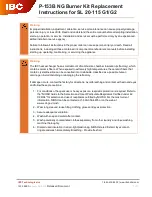
Warning:
Electric shocks can
cause severe burns and life-
threatening injuries. Before
commencing any maintenance work,
isolate the heating system from the power
supply by switching the mains isolator
OFF, and safeguard against unintentional
reconnection (pull the power supply plug
from the plug-in PCB).
Should a sensor or sensor lead develop a fault,
either can be replaced separately, subject to it
not being assembled in the control panel via a
permanent plug-in connection with other
cables/leads. The cables of the internal
equipment components are permanently
connected to the respective PCB plug.
However, the associated leads/cables can be
plugged into the respective component,
enabling an easy replacement of the
component or lead/cable without major
rewiring.
External components (e.g. outside temperature
sensors) or components that are not part of the
standard delivery (e.g. mixers) are connected
to the plugs with screw terminals.
To change the cables/leads, carry out the
following steps: (For the layout of the
individual components, see chapter 4)
1) Remove the lsilencer hood locking screws
(pos. 35 in Fig. 2.2.1), and lift off the hood
(pos. 34 in Fig. 2.2.1).
2) Undo the control panel cover (Fig. 4.4.2)
3) Lift the sensor lead or connecting cable
from the cable duct with strain relief
chicanes inside the control panel
(Fig. 4.4.4).
4) Pull all associated plugs from the PCB
(Fig. 4.4.3).
All PCB plugs are coded to prevent errors
during reconnection.
5) Separate the opposite end of the
lead/cable from the component concerned
(undo plug-in connection).
6) Replace the cable/lead.
Re-assemble in reverse order
Sensors inside the equipment can be replaced
in case of fault, with the exception of the
cylinder sensor, without opening the control
panel.
The flow and return sensors are plugged
straight into the sensor. After the plug has
been pulled, the sensor can be unscrewed
from the boiler body and can be replaced
(Fig. 4.5.1).
The flue gas temperature sensor is fitted via a
gland in the flue gas duct of the boiler and
connected with the sensor lead via a flying
lead (Fig. 4.5.2).
The cylinder temperature sensor is directly
connected at terminals 11/12 of the 12-PIN
sensor plug inside the boiler control panel.
When replacing the leads/cables, follow the
steps 1 to 4. When inserting the sensor into
the sensor well ensure, that the bias spring is
bent so it can be effective (Fig. 4.5.3), and that
the sensor is inserted to the correct depth
(observe the marking).
[ 31 ]
Fig. 4.5.3: Insert the cylinder sensor with
bent spring 70 cm deep into the sensor well
Fig. 4.5.2: Replacing the flue gas temperature sensor (38) ; the sensor can only be replaced complete with the well.
Содержание GasCompactUnit Series
Страница 17: ... 17 Fig 3 4 3 Flue gas system sets ...
Страница 55: ... 55 ...
Страница 58: ... 58 Fig 8 1 Residual head GSU 25 GCU 25 heating side Fig 8 2 Residual head GSU 35 GCU 35 heating side ...
















































